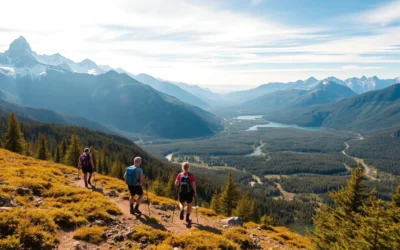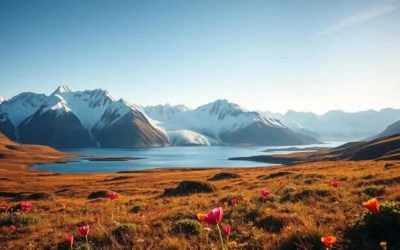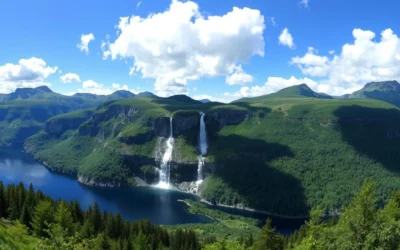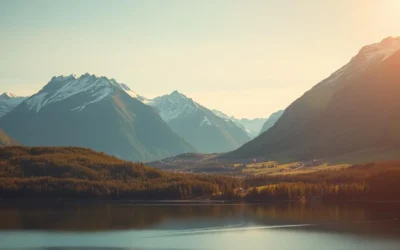✓ Accommodations✓ Flights✓ Rental Cars✓ Tours & Activities
Did you know that Norway has over 1,000 fjords stretching along its coastline, but only two—Geirangerfjord and Nærøyfjord—have earned the prestigious UNESCO World Heritage status? These magnificent waterways represent just a fraction of the breathtaking experiences awaiting visitors in this Nordic wonderland. From chasing the ethereal northern lights to hiking dramatic mountain trails and exploring vibrant cities, Norway offers an unparalleled blend of natural beauty and cultural richness that captivates travelers year-round.
Planning Your Journey to Norway
The UNESCO-listed Geirangerfjord, one of Norway’s most spectacular natural attractions
Norway’s diverse landscapes and seasonal activities require thoughtful planning. Whether you’re drawn to the midnight sun of summer or the northern lights of winter, understanding the country’s geography and climate will help you craft the perfect itinerary. The country stretches over 1,100 miles from south to north, creating significant regional variations in weather, daylight hours, and accessibility.
Your journey begins with deciding which regions to explore. Southern Norway offers the cosmopolitan cities of Oslo and Bergen, along with the famous western fjords. Central Norway features Trondheim and spectacular national parks. Northern Norway beckons with Arctic adventures, the Lofoten Islands, and prime northern lights viewing opportunities. Each region has its distinct character and attractions worth experiencing.
Ready to Start Your Norwegian Adventure?
Find the best flight deals to Norway’s major airports including Oslo, Bergen, Trondheim, and Tromsø.
When to Visit Norway

The magical northern lights illuminate the winter sky near Tromsø
Summer (June to August)
Summer is Norway’s peak tourist season, offering mild temperatures between 15-25°C (60-77°F) and the phenomenon of the midnight sun above the Arctic Circle. This is the ideal time for hiking, fjord cruises, and outdoor activities. The landscape bursts with vibrant colors, waterfalls reach their peak flow, and wildlife is abundant. However, popular attractions can be crowded, and prices for accommodations tend to be at their highest.
Fall (September to October)
Fall brings spectacular foliage as the mountains and forests transform into a canvas of red, orange, and gold. Temperatures cool to 5-15°C (41-59°F), and tourist crowds thin considerably. This shoulder season offers great value for accommodations while still providing access to most summer activities. Late September marks the beginning of the northern lights season in the Arctic regions, making it an excellent time for aurora hunters who prefer milder weather.
Winter (November to March)
Winter transforms Norway into a snow-covered wonderland with temperatures ranging from -10 to 5°C (14-41°F), though the coastal areas remain milder due to the Gulf Stream. This is prime time for northern lights viewing, dog sledding, snowmobiling, and skiing. The polar night—when the sun doesn’t rise—occurs above the Arctic Circle, creating a unique blue twilight atmosphere. Christmas markets and festivals add cultural charm to the winter experience.
Spring (April to May)
Spring brings renewal as snow melts, flowers bloom, and temperatures rise to 5-15°C (41-59°F). Waterfalls and rivers swell with meltwater, creating spectacular displays. This is another excellent value season with fewer tourists and increasing daylight hours. Some mountain roads and hiking trails may still be snow-covered until late May, but coastal areas and cities are fully accessible.
“The best time to visit Norway depends entirely on what you want to experience. Come in winter for the northern lights and snow activities, or summer for hiking and the midnight sun. There’s no wrong season—just different adventures.”
Getting to Norway

Oslo Airport Gardermoen, Norway’s largest international airport
By Air
Most international travelers arrive in Norway by air. Oslo Airport Gardermoen (OSL) is the country’s main international gateway, with direct flights from major cities across Europe, North America, and Asia. Bergen (BGO), Trondheim (TRD), Stavanger (SVG), and Tromsø (TOS) also receive international flights, particularly from European destinations. Norwegian Air, SAS, and numerous international carriers offer regular service to Norway.
By Sea
Ferry connections link Norway with Denmark, Germany, and Sweden. The most popular routes include Copenhagen-Oslo, Kiel-Oslo, and Hirtshals-Kristiansand/Bergen/Stavanger. These comfortable overnight ferries offer an alternative way to bring your vehicle into Norway while enjoying cruise-like amenities. Advance booking is essential, especially during summer months.
By Land
Norway shares land borders with Sweden, Finland, and Russia. Multiple road crossings connect Norway with Sweden along the eastern border, while fewer crossings exist with Finland and Russia in the far north. International trains operate between Oslo and Stockholm, Gothenburg, and Copenhagen, offering scenic journeys through the Scandinavian countryside.
Entry Requirements
Norway is part of the Schengen Area but not the European Union. Visitors from EU/EEA countries can enter with just a national ID card, while travelers from most other countries need a passport valid for at least three months beyond their planned departure date. Some nationalities require a Schengen visa, which should be obtained before travel. Always check the latest requirements with Norwegian immigration authorities or your nearest Norwegian embassy.
Getting Around Norway

The world-famous Flåm Railway offers one of Europe’s most spectacular train journeys
By Air
Domestic flights provide the quickest way to cover Norway’s vast distances. An extensive network operated primarily by SAS, Norwegian, and Widerøe connects major cities and remote communities. The flight from Oslo to Tromsø, for instance, takes just two hours compared to a 20+ hour drive. Booking in advance can secure reasonable fares, especially on competitive routes.
By Train
Norway’s rail network, operated by Vy (formerly NSB), offers some of Europe’s most scenic train journeys. The Bergen Railway crossing the mountainous spine between Oslo and Bergen is particularly spectacular. The Nordland Line to Bodø and the Dovre Line to Trondheim provide additional breathtaking routes. The famous Flåm Railway descends from the mountains to the fjords through incredible landscapes. Comfortable trains feature free Wi-Fi and often panoramic windows for optimal viewing.
By Car
Renting a car gives you the freedom to explore Norway’s scenic byways and remote attractions at your own pace. Roads are excellently maintained, though mountain passes may close in winter. Norway’s National Tourist Routes—18 specially designated scenic roads—offer extraordinary driving experiences with architectural viewpoints and rest areas. Note that speed limits are strictly enforced, winter tires are mandatory in snowy conditions, and some urban areas have congestion charges.
Explore Norway at Your Own Pace
Rent a car to discover hidden gems and scenic routes throughout Norway.
By Bus
An extensive bus network reaches areas not served by trains. Companies like Nor-Way Bussekspress and Nettbuss connect cities and towns with comfortable coaches featuring Wi-Fi and restrooms. Local buses serve smaller communities and rural areas. The Norway in a Nutshell tour combines train, bus, and ferry travel to showcase Norway’s most spectacular scenery in a single journey.
By Boat
Given Norway’s extensive coastline and fjords, boats are an integral part of the transportation system. The Hurtigruten coastal ferry has connected coastal communities for over 125 years, offering both transportation and cruise-like experiences along the western and northern coasts. Local ferries serve as vital links across fjords and to islands, while express boats provide faster connections between coastal towns. In summer, sightseeing boats offer specialized fjord cruises in popular areas.
Where to Stay in Norway

Traditional rorbuer (fishermen’s cabins) in the Lofoten Islands offer unique waterfront accommodations
Hotels
Norway offers accommodations ranging from international luxury chains to charming boutique hotels. Major cities like Oslo, Bergen, and Trondheim feature the widest selection, while smaller towns typically have fewer but often more characterful options. Most Norwegian hotels include an extensive breakfast buffet in the room rate, featuring local specialties like brown cheese (brunost), smoked salmon, and hearty breads. Booking ahead is essential during the summer high season and for northern destinations during prime northern lights periods.
Cabins and Cottages
For a quintessential Norwegian experience, consider staying in a hytte (cabin) or rorbuer (traditional fisherman’s cottage). These range from rustic wilderness retreats without electricity to luxurious waterfront properties with modern amenities. The Norwegian Trekking Association (DNT) maintains a network of mountain cabins along hiking routes, offering affordable accommodations for outdoor enthusiasts. Private cabins can be rented throughout the country, often in spectacular natural settings.
Camping and Glamping
Norway’s allemannsretten (right of public access) allows wild camping in most natural areas, making it a paradise for outdoor enthusiasts. Formal campgrounds provide facilities like showers, electricity, and sometimes cabins for rent. Increasingly popular glamping options offer canvas tents or unique structures with comfortable beds and amenities in stunning locations. For wild camping, remember to follow leave-no-trace principles and camp at least 150 meters from inhabited houses or cabins.
Find Your Perfect Norwegian Accommodation
From luxury hotels to cozy cabins, find the ideal place to stay during your Norwegian adventure.
Unique Stays
Norway excels in distinctive accommodation experiences. Sleep under the northern lights in a glass igloo in Tromsø, stay in a converted lighthouse on the rugged coast, or experience the Snow Hotel in Kirkenes, rebuilt annually from ice and snow. Treehouses, floating cabins, and converted historic buildings offer memorable alternatives to conventional lodging. These unique properties often book out months in advance, so early planning is essential.
Top Attractions and Best Things to Do in Norway

The iconic Trolltunga (Troll’s Tongue) offers one of Norway’s most dramatic viewpoints
Explore the Majestic Fjords
Norway’s fjords represent some of the world’s most spectacular natural wonders. Geirangerfjord and Nærøyfjord, both UNESCO World Heritage sites, offer the quintessential fjord experience with narrow waterways, towering cliffs, and cascading waterfalls. Sognefjord, Norway’s longest and deepest, stretches 205 kilometers inland from the coast. Experience these magnificent waterways by cruise, kayak, or from panoramic viewpoints like Dalsnibba above Geirangerfjord or Stegastein overlooking Aurlandsfjord.
Chase the Northern Lights
Witnessing the aurora borealis dancing across the Arctic sky ranks among life’s most magical experiences. Northern Norway, particularly the regions around Tromsø, Alta, and the Lofoten Islands, offers prime viewing opportunities between September and March. The best displays typically occur on clear, dark nights away from light pollution. Join a guided northern lights chase for optimal chances, as local experts monitor weather conditions and aurora forecasts to find clear skies. For photography enthusiasts, specialized tours offer technical assistance to capture this ethereal phenomenon.
Hike Iconic Mountain Trails
Norway’s dramatic landscapes offer world-class hiking for all ability levels. The most famous routes include Trolltunga (Troll’s Tongue), a challenging 10-12 hour round-trip hike to a rock formation jutting dramatically over Lake Ringedalsvatnet; Preikestolen (Pulpit Rock), a more accessible 4-6 hour hike to a flat cliff platform 604 meters above Lysefjord; and Kjeragbolten, where adventurous hikers can stand on a boulder wedged between mountain crevices with a 984-meter drop below. For multi-day adventures, the extensive trail network maintained by the Norwegian Trekking Association provides marked routes and mountain cabins.

The UNESCO-listed Bryggen wharf in Bergen showcases colorful medieval architecture
Discover Vibrant Cities
Norway’s cities blend historical charm with contemporary Scandinavian design. Oslo, the capital, offers world-class museums like the Viking Ship Museum and the striking Oslo Opera House, along with the sculpture-filled Vigeland Park. Bergen enchants visitors with its colorful Bryggen wharf, a UNESCO World Heritage site, and the panoramic views from Mount Fløyen. Trondheim features the impressive Nidaros Cathedral and a charming old town, while Tromsø serves as the “Gateway to the Arctic” with its rich polar history and vibrant cultural scene.
Experience Arctic Adventures
Northern Norway provides unique Arctic experiences year-round. In winter, try dog sledding through snow-covered forests, snowmobiling across frozen landscapes, or ice fishing on mountain lakes. Summer brings the midnight sun, when the sun never sets above the Arctic Circle, creating perfect conditions for hiking, wildlife safaris, and sea kayaking. For the ultimate Arctic experience, visit Svalbard, one of the world’s northernmost inhabited areas, where you might spot polar bears, reindeer, and Arctic foxes against a backdrop of glaciers and mountains.
Discover Unforgettable Norwegian Experiences
Book guided tours, fjord cruises, northern lights excursions, and more unforgettable activities.
Activities & Sightseeing
Ride Scenic Railways
Norway’s railway journeys rank among the world’s most beautiful. The Bergen Railway crosses Europe’s highest mountain plateau between Oslo and Bergen, while the Flåm Railway descends from the mountains to the fjords through 20 tunnels in just 20 kilometers. The Nordland Line to Bodø crosses the Arctic Circle, offering spectacular coastal and mountain scenery. These train journeys provide not just transportation but unforgettable experiences in themselves, especially when combined with connecting fjord cruises in the popular “Norway in a Nutshell” route.

Dog sledding through snowy forests is a thrilling winter activity in Northern Norway
Cultural Experiences in Norway

Sami people in traditional dress with reindeer in Finnmark, Northern Norway
Discover Viking Heritage
Norway’s Viking history comes alive at numerous sites across the country. The Viking Ship Museum in Oslo displays remarkably preserved vessels from the 9th century, while the Lofotr Viking Museum in the Lofoten Islands features a reconstructed longhouse where visitors can experience Viking-era daily life. Archaeological sites like Avaldsnes on Karmøy island and Borre National Park contain ancient burial mounds and artifacts. Viking festivals throughout summer offer opportunities to witness reenactments, traditional crafts, and even Viking ship sailings.
Experience Sami Culture
The Sami, Norway’s indigenous people, maintain their distinctive culture primarily in the northern regions. Visit Karasjok or Kautokeino to experience Sami traditions, reindeer herding, and handicrafts. The Sami National Day (February 6) brings colorful celebrations, while year-round cultural centers like Sápmi Park offer insights into traditional and contemporary Sami life. Ethical tourism experiences include staying in lavvu (traditional tents), learning about duodji (handicrafts), and enjoying joik (traditional singing).
Savor Norwegian Cuisine
Norwegian food reflects the country’s mountains, forests, and extensive coastline. Sample fresh seafood like king crab from the Barents Sea, salmon prepared in countless ways, and traditional preserved fish like lutefisk and rakfisk. Game meats including reindeer, elk, and grouse feature prominently in northern and inland regions. Don’t miss brunost (brown cheese), heart-shaped waffles with sour cream and jam, and skillingsboller (cinnamon buns). Norway’s food scene has evolved dramatically, with Oslo, Bergen, and Stavanger now home to Michelin-starred restaurants emphasizing local, seasonal ingredients.

The 12th-century Borgund Stave Church showcases Norway’s unique medieval wooden architecture
Visit Historic Stave Churches
Norway’s wooden stave churches represent unique medieval architecture found nowhere else. Of the original 1,000+ churches built between the 12th and 14th centuries, only 28 remain. The most impressive include Borgund Stave Church in Sogn, with its tiered roofs and dragon-head decorations; Urnes Stave Church, a UNESCO World Heritage site featuring intricate wood carvings; and Heddal Stave Church, Norway’s largest. These architectural treasures combine Christian symbolism with Viking-era decorative elements, providing a fascinating glimpse into Norway’s religious and cultural transition period.
Outdoor Activities for Every Season

Kayaking through Norway’s fjords offers a unique perspective on these natural wonders
Summer Activities
Norway’s long summer days provide endless opportunities for outdoor adventures. Hiking trails crisscross the country, from family-friendly coastal paths to challenging mountain routes. Kayaking and canoeing allow intimate exploration of fjords and lakes, while fishing enthusiasts can target salmon in world-famous rivers or try sea fishing along the extensive coastline. Mountain biking trails range from gentle forest paths to technical alpine routes. For adrenaline seekers, Norway offers white-water rafting, paragliding, and rock climbing in spectacular settings.
Winter Activities
When snow blankets the landscape, Norway transforms into a winter sports paradise. World-class ski resorts like Trysil, Hemsedal, and Geilo offer alpine skiing and snowboarding for all levels. Cross-country skiing—Norway’s national pastime—can be enjoyed on thousands of kilometers of groomed trails throughout the country. Beyond skiing, winter visitors can try snowshoeing through silent forests, ice fishing on frozen lakes, or ice climbing frozen waterfalls. For a uniquely Norwegian experience, join locals for a refreshing winter swim followed by a traditional sauna session.
Wildlife Watching
Norway’s diverse ecosystems support remarkable wildlife viewing opportunities. Coastal safaris offer chances to spot whales, seals, and sea eagles, with Andenes, Tromsø, and the Lofoten Islands being prime locations. On land, moose, reindeer, and foxes inhabit forests and mountains, while the more fortunate might glimpse wolverines, lynx, or even wolves in remote areas. Svalbard represents the ultimate wildlife destination, where polar bears roam among Arctic foxes, walruses, and numerous seabird colonies. Responsible wildlife tours emphasize animal welfare and conservation.

Norway offers world-class skiing with spectacular mountain backdrops
Practical Tips for Visiting Norway

Proper layered clothing is essential for comfort in Norway’s changeable weather
Money Matters
Norway uses the Norwegian krone (NOK), not the euro. While credit cards are accepted almost everywhere—even for small purchases—it’s advisable to carry some cash for remote areas. Norway ranks among the world’s most expensive countries, with high prices for dining, accommodations, and transportation. Budget travelers can save by self-catering, using public transportation, and taking advantage of free outdoor activities. The tax-free shopping scheme allows non-EU/EEA visitors to reclaim VAT on purchases over 315 NOK when leaving the country.
Packing Essentials
Norway’s weather can change rapidly, making layered clothing essential year-round. Even summer visitors should pack waterproof jackets, warm layers, and good hiking boots. Winter travelers need proper thermal underwear, insulated waterproof outerwear, and accessories like ice grips for shoes. Regardless of season, bring sunglasses (for snow glare in winter and long daylight hours in summer), a camera with extra batteries (cold weather depletes them quickly), and a reusable water bottle (Norwegian tap water is excellent). If planning northern lights photography, a tripod and appropriate camera settings are crucial.
Language and Communication
While Norwegian is the official language, English is widely spoken throughout the country, especially among younger generations and in the tourism industry. Learning a few basic Norwegian phrases like “takk” (thank you) and “god morgen” (good morning) is appreciated but not necessary. Mobile coverage is excellent in populated areas, though some remote mountain and fjord regions may have limited service. Most accommodations, cafés, and public spaces offer free Wi-Fi, making it easy to stay connected.
Is Norway expensive to visit?
Yes, Norway ranks among the world’s most expensive countries for travelers. Expect to pay around 150-250 NOK ($15-25) for a basic meal, 1000-2000 NOK ($100-200) for mid-range accommodations, and 30-40 NOK ($3-4) for a coffee. Budget travelers can reduce costs by staying in hostels or cabins, self-catering, using public transportation, and focusing on free outdoor activities.
When is the best time to see the northern lights in Norway?
The northern lights are visible from late September to early April in Northern Norway, with peak viewing opportunities from November to February when darkness prevails. Clear, dark nights away from light pollution offer the best conditions. The aurora is never guaranteed, but staying for at least 3-4 nights in the Arctic region significantly increases your chances of a sighting.
Do I need a visa to visit Norway?
Norway is part of the Schengen Area. Visitors from EU/EEA countries can enter with just a national ID card, while travelers from the US, Canada, Australia, and many other countries can visit for up to 90 days without a visa. Always check current requirements with Norwegian immigration authorities or your nearest Norwegian embassy before traveling.
Safety Information

Norway’s mountain trails are well-marked with red “T” symbols for safety
Norway consistently ranks as one of the world’s safest countries, with low crime rates and excellent emergency services. However, nature presents the greatest risks to visitors, particularly in mountain and coastal areas. Weather conditions can change rapidly, with storms developing quickly in mountain regions. Always check weather forecasts before outdoor activities and be prepared to adjust plans accordingly.
When hiking, stay on marked trails, inform someone of your route and expected return time, and carry appropriate equipment including maps, extra food, water, and warm clothing. The Norwegian Mountain Code (Fjellvettreglene) provides essential safety guidelines that all hikers should follow. In winter, avalanche awareness is crucial for backcountry skiing and snowmobiling.
For emergency assistance, dial 112 for police, 113 for medical emergencies, or 110 for fire. These services operate in English as well as Norwegian. The Norwegian Red Cross operates mountain rescue services throughout the country, with volunteers ready to assist in emergencies.
The Norwegian Mountain Code
- Plan your trip and inform others about the route you have selected.
- Adapt the planned routes according to ability and conditions.
- Pay attention to the weather and the avalanche warnings.
- Be prepared for bad weather and frost, even on short trips.
- Bring the necessary equipment so you can help yourself and others.
- Choose safe routes. Recognize avalanche terrain and unsafe ice.
- Use a map and a compass. Always know where you are.
- Don’t be ashamed to turn around.
- Conserve your energy and seek shelter if necessary.
Local Etiquette

Friluftsliv (outdoor life) is central to Norwegian culture and identity
Norwegians value punctuality, directness, and personal space. When meeting locals, a firm handshake and direct eye contact are appropriate. Casual dress is acceptable in most situations, though Norwegians tend to dress neatly and practically. Remove shoes when entering someone’s home unless told otherwise.
Tipping is not as ingrained in Norwegian culture as in some countries. In restaurants, a service charge is typically included, but rounding up the bill or adding 5-10% for exceptional service is appreciated. Taxi drivers don’t expect tips, but rounding up is common. Tour guides and hotel staff appreciate small gratuities for outstanding service.
Environmental consciousness runs deep in Norwegian society. Follow leave-no-trace principles when enjoying nature, properly dispose of waste, and respect wildlife. The concept of “allemannsretten” (right of public access) allows everyone to enjoy nature responsibly, even on private land, provided you stay at least 150 meters from dwellings and leave no trace of your visit.
Alcohol consumption is regulated, with sales of beverages above 4.75% ABV limited to state-run Vinmonopolet stores with restricted hours. Public drinking is generally not acceptable outside designated areas like restaurant terraces. Drinking and driving laws are extremely strict, with a blood alcohol limit of just 0.02%.
Conclusion

The magical light of sunset transforms Norway’s landscapes into unforgettable scenes
Norway captivates visitors with its extraordinary blend of natural wonders, cultural richness, and outdoor adventures. From the deep blue fjords carving through ancient mountains to the ethereal dance of the northern lights across Arctic skies, this Nordic nation offers experiences that linger in memory long after your journey ends. Whether you’re hiking to dramatic viewpoints, exploring vibrant cities, or immersing yourself in Viking heritage, Norway rewards travelers with moments of awe and discovery.
While planning your Norwegian adventure requires consideration of seasonal variations, transportation logistics, and budget management, the rewards far outweigh the challenges. The country’s excellent infrastructure, English proficiency, and commitment to sustainable tourism make it accessible to international visitors, while its vast wilderness areas and distinctive cultural traditions ensure authentic experiences away from the crowds.
As you stand at the edge of a towering fjord, witness the midnight sun painting mountains in golden light, or feel the exhilaration of spotting your first northern lights display, you’ll understand why Norway inspires such passion among travelers. This land of extraordinary natural beauty and warm hospitality awaits your exploration—are you ready for the adventure of a lifetime?
The above is subject to change.
Check back often to TRAVEL.COM for the latest travel tips and deals.






